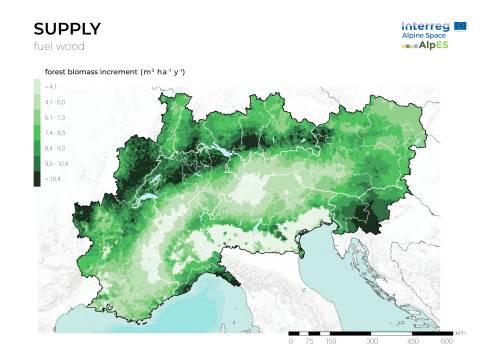Table of Contents
Fuel wood
Large swaths of forested land are one of the defining features of the Alps. These numerous forests provide for many social and economic benefits: one of the most significant being timber. Timber can be processed in numerous ways and serve a variety of purposes: from constructing buildings to being burned as fuel. Traditionally, fuel wood was used in homes all across the Alps. Today, the use of fuel wood is less consistent, and varies dramatically by region. However, as alternative and sustainable energy sources become more sought after, fuel wood is once again becoming a vital energy source across the region.
In order to better understand the benefits humans derive from fuel wood, it is important to identify how much wood ecosystems supply, how much wood humans take from these systems, and finally how much demand exists for heating that could be met by this source. Many factors affect these values, such as the rate at which a forest grows, how accessible wood resources are for extraction, and the caloric content of wood used for heating.
This suite of indicators evaluates these three components and maps them across the Alpine Space. By doing so, this ecosystem service can be included in adaptive management that meets the heating and energy needs of the present and the future.
Fuel wood – Flow
Description This indicator measures the total annual wood removals - based on national inventories - for fuel wood production, considering also the forest accessibility and the technical feasibility of harvesting due to topographical site conditions.

View this map in the AlpES webGIS
Forest management is only possible if there is viable infrastructure to reach the felling sites. Moreover, topographical site conditions affect the technical feasibility of the tree felling activities and the subsequent collection and transportation of the timber. All these factors, together with data on the forests available for wood supply, were utilized to develop the flow indicator for fuel wood.
The resulting map shows a heterogeneous distribution of the flow rates for fuel wood; high values can be observed in the eastern (Slovenia and east Austria) and the northwestern (upper Switzerland and France) parts of the Alpine Space. Such areas present the most accessible and workable forests, which also have a reasonably high supply. The southern areas of the Alpine Space and the central mountain ridge score
Fuel wood – Demand
Description
This indicator quantifies the potential municipal demand for fuel wood on the basis of statistics on fuelwood consumption and building area, considering also the annual average temperature across the different alpine regions.
View this map in the AlpES webGIS
Comment
The demand for fuel wood as an energy source is highly variable across the Alps and high-resolution data on energy utilization is scarce. Hence, this indicator estimates the hypothetical fuel wood requirements for heating purposes per municipality. The resulting map has a mosaic pattern, yet most big cities are easily recognizable due to their large population numbers, and consequently high energy demand.
Figure 3.7 compares the different heating and cooling systems used in different European countries: fuel wood is the predominant heating system only in Sweden, Latvia and Finland, whereas in the Alpine countries the favored heating source is natural gas. Nonetheless, biomass is currently the most widely used renewable energy source for heating, representing some 90% of all renewable heating as of 2012.
With the 2020 Energy Strategy, the EU aims to reduce its greenhouse gas emissions by at least 20% and increase the share of renewable energy to at least 20% of consumption by 2020, while also achieving energy savings of 20% or more.